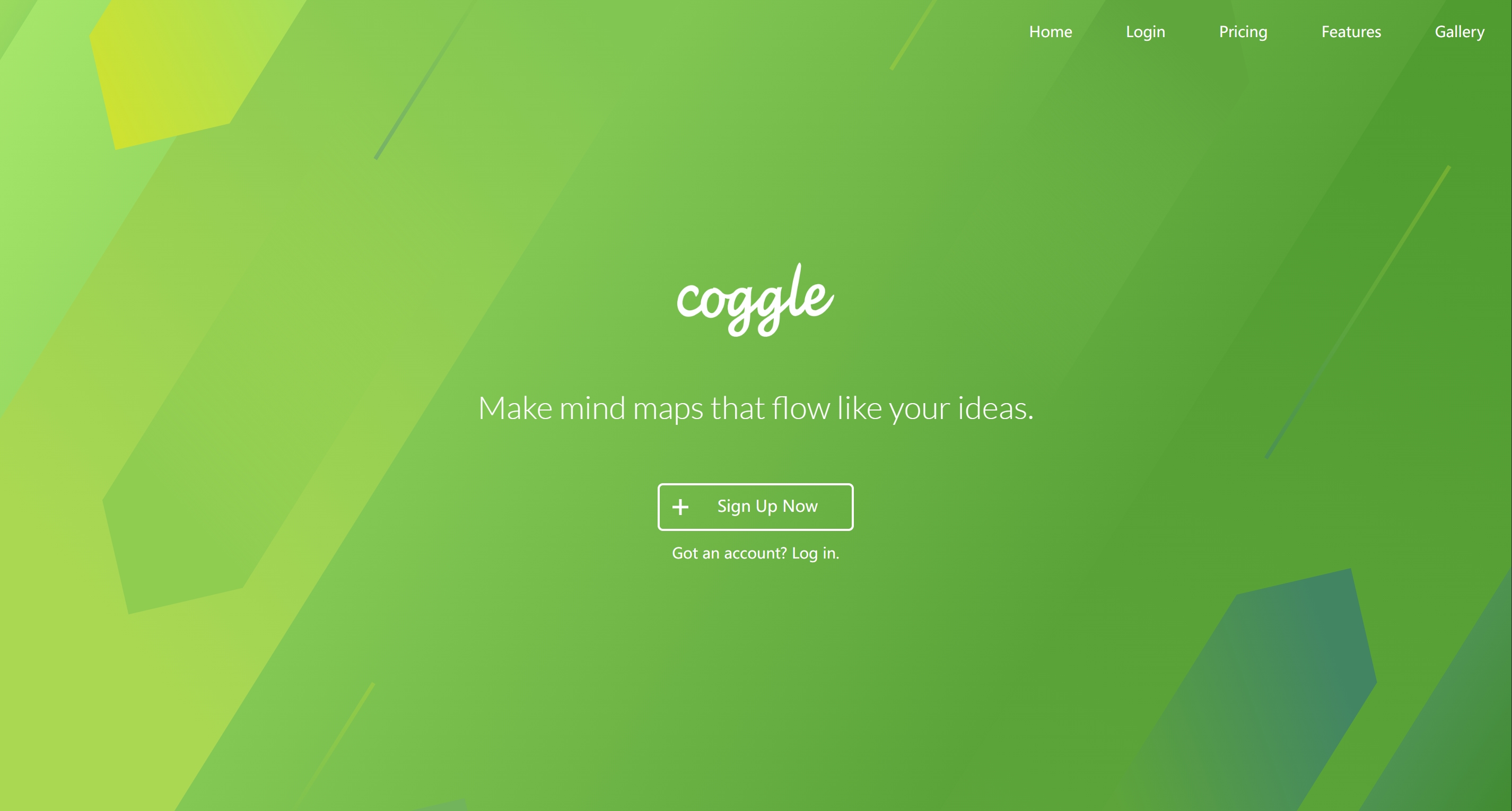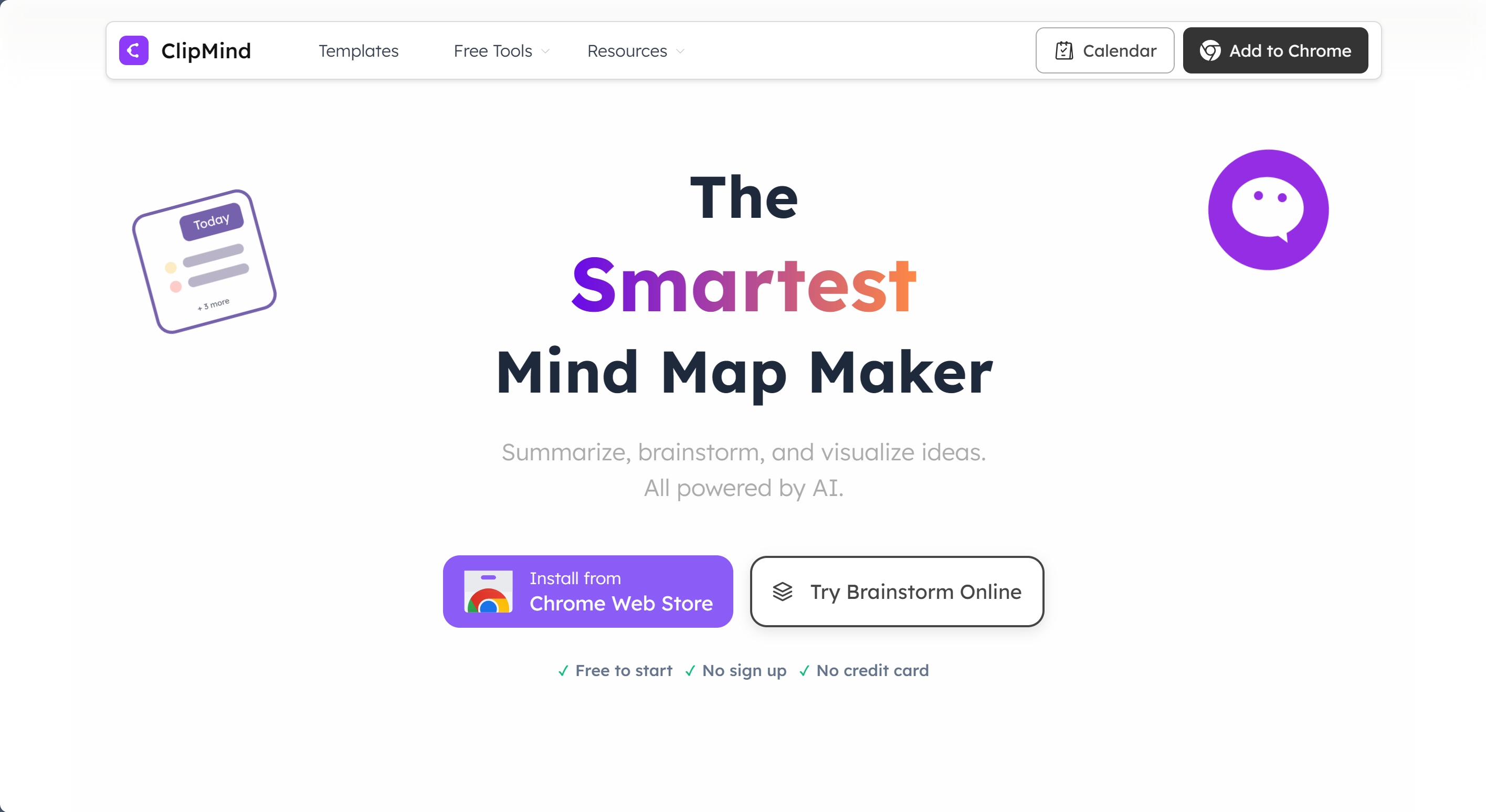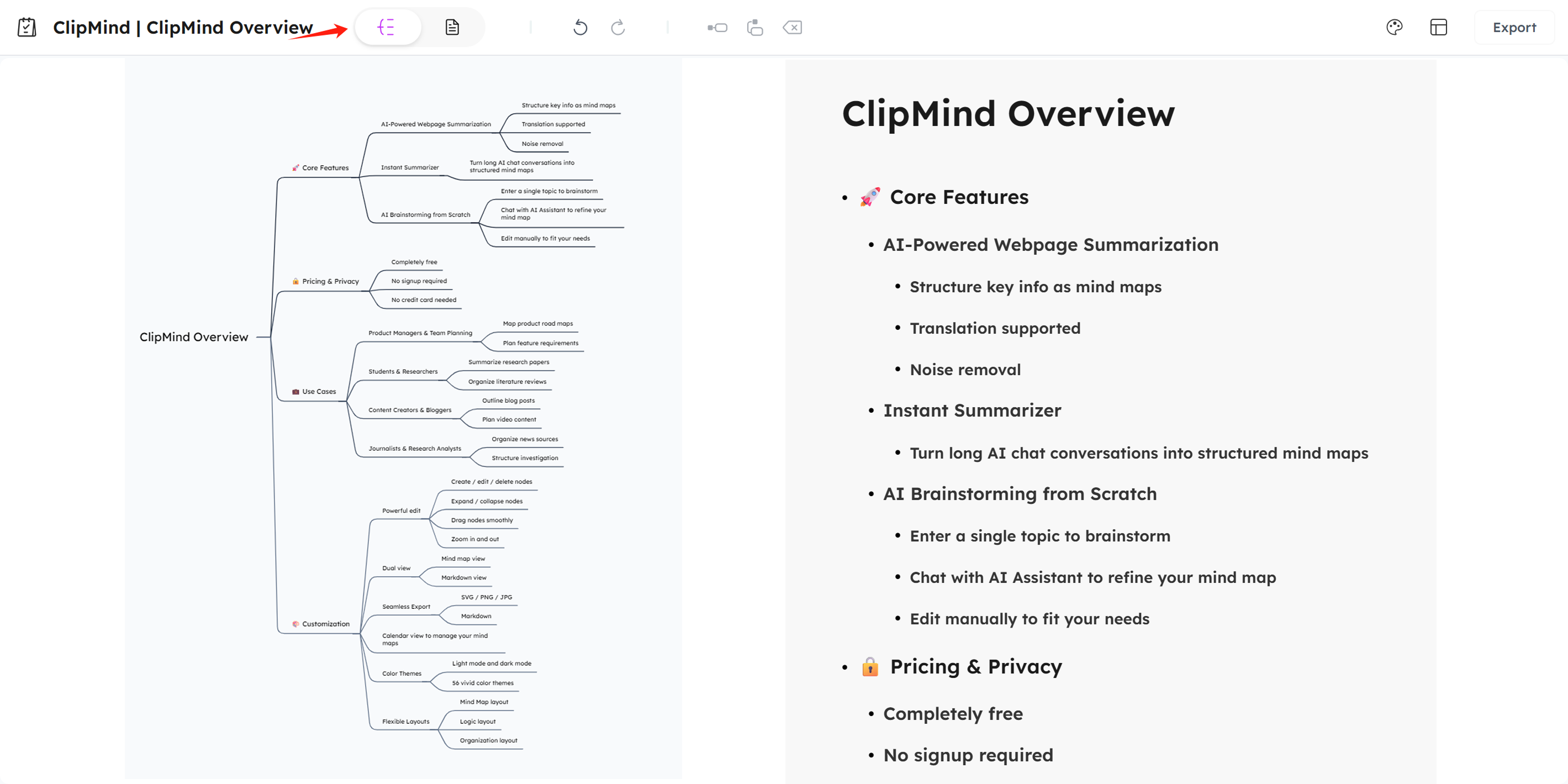TL; DR
- ClipMind offers completely free access with no private map limitations, unlike Coggle's three-private-map restriction on its free tier
- Coggle excels at real-time team collaboration with unlimited users, while ClipMind's AI summarization transforms research articles into editable mind maps instantly
- The AI assistant in ClipMind acts as a thought partner for expanding ideas, bridging the gap between content comprehension and structured thinking
- Coggle's strength lies in manual diagram creation and flowchart capabilities, ideal for team brainstorming sessions
- ClipMind's dual-view workflow (mind map and Markdown) enables seamless switching between visual thinking and structured writing
Introduction
Choosing the right mind mapping tool can significantly impact how you process information, collaborate with teams, and transform ideas into actionable insights. As someone who's tested numerous mind mapping solutions for research and team projects, I've found that the decision often comes down to a fundamental choice: traditional collaborative tools versus AI-powered structured thinking platforms.
This comparison examines two distinct approaches to mind mapping: Coggle's established collaborative platform and ClipMind's AI-native methodology. While Coggle has built its reputation on real-time team diagramming, ClipMind addresses the growing need to bridge content consumption with knowledge creation. The choice matters because research shows that 41% of mind mapping software users save an average of 1 to 3 hours per week using these tools, making the right selection crucial for productivity.
Decision Criteria: What Matters Most in Mind Mapping Tools
When evaluating mind mapping tools, several key factors determine whether a solution will genuinely enhance your workflow. Through testing various platforms across different projects, I've identified six critical evaluation criteria that align with how different user personas approach mind mapping.
Core Evaluation Factors
The most important considerations break down into three categories: functionality, accessibility, and value. Functionality encompasses AI capabilities, collaboration features, and export options. Accessibility covers ease of use and platform availability, while value includes pricing and privacy considerations.
Different user profiles prioritize these factors differently. Students and researchers often need robust research summarization and academic citation management. Product managers typically prioritize collaboration features and integration with project management tools. Individual knowledge workers might value privacy and cost-effectiveness above all else.
User Persona Priorities
Research comparing traditional user research approaches with AI persona generation methods highlights how different users approach tool selection. Students typically prioritize cost, ease of use, and research capabilities. Product managers need real-time collaboration and project integration. Researchers value comprehensive export options and data organization features.
Understanding your primary use case helps determine which features matter most. If you're mainly summarizing research papers, AI capabilities become crucial. For team brainstorming sessions, collaboration features take priority. Individual users might prioritize privacy and cost considerations.
At-a-Glance Comparison Table
| Feature | Coggle | ClipMind |
|---|---|---|
| AI Capabilities | Limited | ✅ Summarization, brainstorming, assistant |
| Real-time Collaboration | ✅ Unlimited users | ❌ Individual-focused |
| Free Tier Limitations | 3 private diagrams | ✅ Completely unlimited |
| Export Options | PNG, PDF, Text | PNG, SVG, JPG, Markdown |
| Dual View Mode | ❌ | ✅ Mind map + Markdown |
| Pricing Model | Freemium ($5/month) | Completely free |
| Mobile Experience | Limited mobile app | Browser-based access |
| Learning Curve | Low | Moderate |
| Best For | Team collaboration, flowcharts | Research, individual knowledge work |
This comparison reveals two fundamentally different approaches: Coggle focuses on collaborative diagram creation, while ClipMind emphasizes AI-powered knowledge structuring. The choice depends on whether your primary need is team brainstorming or individual comprehension and ideation.
Deep Dive: Coggle Strengths and Limitations
Coggle has established itself as a reliable choice for teams needing straightforward mind mapping with robust collaboration features. After using it for several team projects, I've identified both its strengths and areas where it falls short for certain workflows.

Collaboration Excellence
Coggle's standout feature is undoubtedly its real-time team collaboration capabilities. Multiple users can simultaneously edit diagrams, with changes appearing instantly for all participants. This makes it ideal for remote brainstorming sessions where team members need to contribute ideas in real-time.
The platform supports unlimited collaborators even on its free tier, which is rare in the mind mapping space. During testing, I found this particularly valuable for large team projects where numerous stakeholders need input. The comment system and change history provide clear audit trails of collaborative contributions.
Pricing and Limitations
Coggle operates on a freemium model that becomes restrictive for individual users. The free version limits you to three private diagrams, forcing frequent cleanup or upgrades to the $5/month Awesome Plan. While affordable for teams, this can be frustrating for individual users who need to maintain multiple private maps for different projects.
The Awesome Plan does offer valuable features like unlimited private diagrams, image uploads, and flowchart shapes. However, the mandatory upgrade for basic privacy needs represents a significant limitation compared to completely free alternatives.
Customization Constraints
Coggle maintains a clean, minimalist interface that prioritizes simplicity over customization. While this reduces the learning curve, it also limits visual customization options. Users looking for extensive styling, multiple layout options, or advanced formatting may find Coggle too restrictive.
The mobile experience, while functional, doesn't match the desktop capability. The interface feels cramped on smaller screens, and some advanced features are less accessible. For users who need robust mobile mind mapping, this represents a significant limitation.
Deep Dive: ClipMind's AI-Powered Approach
ClipMind represents the next evolution in mind mapping tools by integrating AI directly into the knowledge structuring process. Rather than just visualizing existing ideas, it helps generate and refine thoughts through three distinct AI capabilities that address common knowledge work challenges.

AI Summarization Capabilities
The most transformative feature is ClipMind's ability to summarize any webpage into an editable mind map with a single click. This directly addresses the gap between content consumption and structured understanding that traditional tools like Coggle don't solve. Instead of manually building maps from research materials, ClipMind automatically extracts key points and organizes them hierarchically.
During testing, I found this particularly valuable for academic research and competitive analysis. Summarizing a 3,000-word article took approximately 15 seconds, producing a structured map that captured all major points and their relationships. The output remains fully editable, allowing users to refine, expand, or reorganize the AI-generated structure.

Dual-View Workflow
ClipMind's dual-view system enables seamless switching between visual mind maps and structured Markdown. This bridges the gap between brainstorming and documentation, allowing users to start with visual thinking and transition smoothly to linear writing. The Markdown view provides a clean, text-based perspective that's ideal for exporting to reports, documentation, or publishing platforms.
The ability to toggle between views maintains conceptual relationships while adapting to different working styles. During idea development, the mind map view helps visualize connections, while the Markdown view facilitates detailed elaboration and organization.

Completely Free Model
Unlike Coggle's restrictive freemium approach, ClipMind offers completely unlimited access without login requirements or feature limitations. This makes it accessible to students, individual researchers, and anyone working with sensitive information who prioritizes privacy. The absence of pricing tiers eliminates the constant calculation of whether an additional private map justifies upgrade costs.
The privacy-focused design ensures that all content stays on your device, with no data collection or cloud storage requirements. For users handling confidential research, client information, or personal projects, this represents a significant advantage over cloud-based alternatives.
Workflow Comparison: From Idea to Execution
The fundamental difference between Coggle and ClipMind becomes most apparent when examining complete workflows from initial idea to final execution. Each tool supports different cognitive processes and produces distinct outcomes.
Research and Comprehension Workflow
For research-intensive tasks, ClipMind's AI summarization creates a significant efficiency advantage. The typical workflow involves reading an article or research paper, then using ClipMind to generate an initial mind map structure. The AI assistant can then help expand specific sections, identify connections between concepts, or translate content while maintaining the hierarchical structure.
In contrast, Coggle requires manual transcription of key points from research materials. While this can promote deeper engagement with content, it also consumes substantially more time. For users processing large volumes of information, the manual approach becomes impractical.
Brainstorming and Ideation Process
Both tools support brainstorming, but through different mechanisms. Coggle excels at collaborative brainstorming sessions where multiple team members contribute simultaneously. The real-time updates and simple interface make it ideal for capturing ideas during meetings or workshops.
ClipMind enhances individual brainstorming through AI assistance. Starting with a central topic, the AI can generate related concepts, identify potential connections, and suggest organizational structures. This acts as a thought partner rather than just a visualization tool, helping overcome creative blocks and explore ideas more comprehensively.
Documentation and Output Generation
When moving from ideas to executable documents, ClipMind's Markdown export provides a clear advantage. The ability to switch between visual and text views means the mind map can directly evolve into an outline, report, or article structure. Exporting as Markdown creates immediately usable content for various publishing platforms.
Coggle's export options focus on visual presentations rather than structured content. While excellent for sharing diagrams or including in presentations, they don't facilitate the transition from visual thinking to written execution as seamlessly.
Hands-On Scenarios and Results
To provide concrete comparisons, I tested both tools across three common scenarios that represent different mind mapping use cases. The results highlight each tool's strengths in specific contexts.
Test Case 1: Research Article Summarization
For summarizing a 2,500-word research paper about mind mapping effectiveness, ClipMind completed the task in under 20 seconds, producing a comprehensive map with all major sections and key findings. The AI accurately identified the hierarchy of information and created logical relationships between concepts.
Using Coggle for the same task required approximately 45 minutes of manual work. While the final diagram was visually clean, the time investment made this approach impractical for regular research work. The research demonstrating that mind mapping significantly improves academic performance highlights why efficient summarization matters for students and researchers.
Test Case 2: Product Feature Brainstorming
For brainstorming new features for a productivity app, Coggle's collaboration features shone. With three team members contributing simultaneously, we generated 40+ ideas in 30 minutes, with natural grouping emerging through color coding and spatial organization.
ClipMind's AI brainstorming generated a more structured approach, suggesting feature categories we hadn't considered and identifying potential user experience implications. The AI assistant helped refine vague concepts into specific feature descriptions, though the individual nature meant missing the spontaneous creativity of group collaboration.
Test Case 3: Project Planning Documentation
Creating a project plan from initial brainstorming to executable tasks revealed ClipMind's dual-view advantage. Starting with a visual map of project components, switching to Markdown view created a natural transition to task lists, timelines, and responsibility assignments. The exported Markdown integrated seamlessly with project management tools.
Coggle produced an excellent visual project overview but required manual transcription to create actionable task lists. The visual diagram served as excellent communication tool but didn't facilitate the transition to execution as effectively.
When to Choose Coggle vs ClipMind
Based on extensive testing and workflow analysis, each tool serves distinct user needs and working styles. The decision matrix below helps identify the right choice for specific scenarios.
Choose Coggle When...
Coggle excels in collaborative environments where multiple stakeholders need to contribute simultaneously. Choose Coggle if your primary use cases involve:
- Team brainstorming sessions with real-time participation
- Flowchart creation and process mapping
- Client presentations requiring clean, professional diagrams
- Educational settings where multiple students contribute to group projects
- Situations requiring manual control over every aspect of diagram creation
The platform's strength lies in its simplicity and collaborative focus, making it ideal for groups that prioritize shared creation over automated assistance.
Choose ClipMind When...
ClipMind addresses knowledge work challenges that traditional tools overlook. Choose ClipMind if your workflow involves:
- Research summarization and academic work
- Individual knowledge management and personal projects
- AI-assisted thinking and idea development
- Privacy-sensitive information that shouldn't be stored in the cloud
- Budget constraints that make subscription models impractical
- Transitioning between visual thinking and written documentation
Hybrid Approaches
For users with diverse needs, both tools can complement each other. Use ClipMind for individual research and idea development, then export key insights to Coggle for team collaboration and refinement. This approach leverages each tool's strengths while mitigating their limitations.
Pricing and Value Analysis
The pricing models represent fundamentally different philosophies about accessibility and value. Coggle follows the traditional SaaS freemium approach, while ClipMind challenges this model with completely free access.
Coggle's Pricing Structure
Coggle's free tier serves as an extended trial rather than a fully functional solution. The three-private-diagram limitation forces frequent decisions about which projects to keep active and which to archive or delete. The $5/month Awesome Plan removes this restriction and adds features like image uploads and advanced sharing options.
For individual users, this represents ongoing expense for basic functionality. For teams, the cost scales with user count, making it manageable for organizational budgets but potentially expensive for casual users.
ClipMind's Value Proposition
ClipMind's completely free access with no feature limitations represents exceptional value for individual users. The absence of subscription costs, combined with robust AI capabilities, creates a compelling proposition for students, researchers, and individual professionals.
The value extends beyond monetary savings to include privacy protection and workflow efficiency. Users avoid the constant evaluation of whether their usage justifies subscription costs, allowing focus on actual work rather than cost-benefit calculations.
Total Cost of Ownership
When calculating total cost, consider both direct financial outlay and time investment. Coggle's subscription cost is straightforward but ongoing. ClipMind's free access eliminates financial cost but may require slightly more initial learning due to its advanced features.
For heavy users, ClipMind's AI capabilities can deliver significant time savings that offset any learning curve. Research shows that mind mapping tools can deliver 30% time savings when properly integrated into workflows, making efficiency gains a crucial factor in value assessment.
Conclusion and Recommendation
The choice between Coggle and ClipMind ultimately depends on your primary use cases and working style. Both tools represent excellent solutions for different mind mapping approaches and user needs.
Coggle remains the superior choice for team collaboration and straightforward diagram creation. Its real-time editing, simple interface, and reliable performance make it ideal for groups that need to brainstorm and diagram together. The platform excels when the process of collaborative creation matters as much as the final output.
ClipMind revolutionizes individual knowledge work through AI-powered comprehension and structuring. The ability to instantly transform research into editable mind maps, combined with dual-view workflow and completely free access, makes it invaluable for students, researchers, and individual professionals. Its AI capabilities address the growing challenge of information overload in ways traditional tools cannot match.
For most individual users and knowledge workers, ClipMind offers the more comprehensive solution to modern information processing challenges. The AI summarization alone can transform how you approach research and content comprehension, while the completely free model removes financial barriers to access.
Learn More
- ClipMind Free AI Tools
- How to Create Mind Maps from Webpages: Complete Guide
- 10 Best Mind Map Software for Beginners in 2025
- Professional Mind Mapping Tools Should Offer Advanced Features
- Mind Mapping for Project Management Phases
FAQs
-
Can I use both Coggle and ClipMind together? Yes, many users employ both tools for different purposes. Use ClipMind for research summarization and individual idea development, then export key insights to Coggle for team collaboration and refinement.
-
Does ClipMind work on mobile devices? ClipMind works through web browsers on mobile devices, providing access to all features without requiring a dedicated mobile app. The interface adapts to different screen sizes for usable mobile experience.
-
How many collaborators can use Coggle simultaneously? Coggle supports unlimited collaborators on all plans, including the free tier. Multiple users can edit the same diagram in real-time, with changes appearing instantly for all participants.
-
Is ClipMind really completely free with no limitations? Yes, ClipMind offers all features completely free with no restrictions on private maps, export options, or AI usage. There are no plans to introduce pricing tiers or feature limitations.
-
Which tool is better for academic research? ClipMind's AI summarization capabilities make it significantly more efficient for academic research. The ability to instantly create structured maps from research papers saves substantial time compared to manual diagram creation.
-
Can I export Coggle diagrams to other formats? Coggle supports export to PNG, PDF, and text formats. However, it doesn't offer Markdown export or the dual-view functionality that ClipMind provides for transitioning between visual and text-based work.
-
How does ClipMind's AI compare to traditional mind mapping? ClipMind's AI acts as a thought partner that helps generate, expand, and refine ideas, while traditional tools like Coggle focus on manual visualization. This makes ClipMind better for idea development and Coggle better for precise diagram control.
